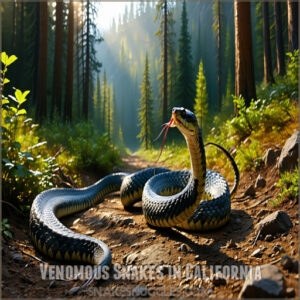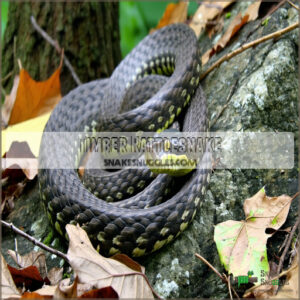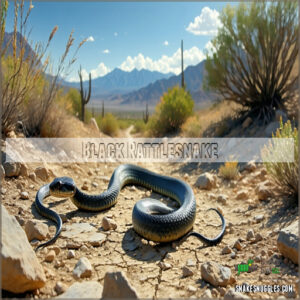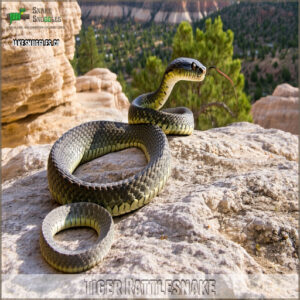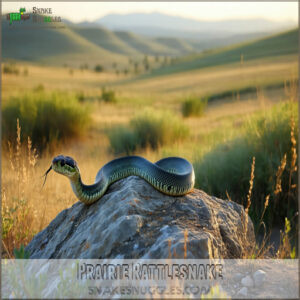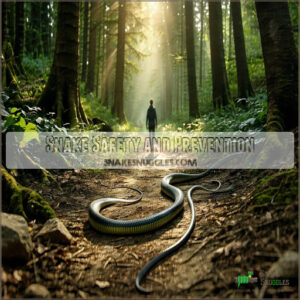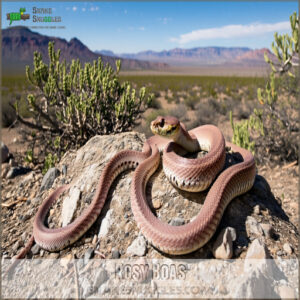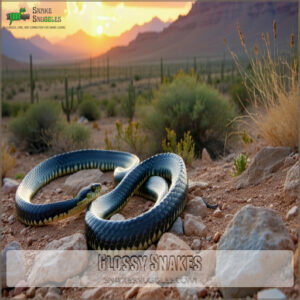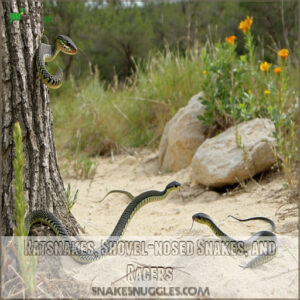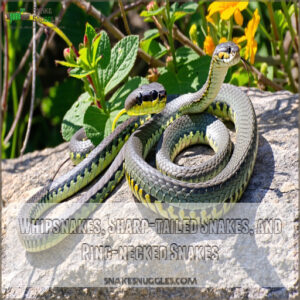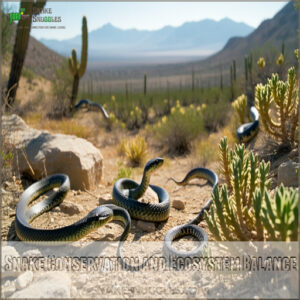This site is supported by our readers. We may earn a commission, at no cost to you, if you purchase through links.
 California is home to some seriously venomous snakes, so staying alert is key. The Western Diamondback is one to watch—its hemotoxic venom can cause serious damage, and it’s not shy if threatened. The Mojave Rattlesnake has venom with a wicked mix of neurotoxic and hemotoxic effects, making it tricky to handle. Don’t forget the Southern Pacific Rattlesnake, known for its potent venom and love for rocky habitats.
California is home to some seriously venomous snakes, so staying alert is key. The Western Diamondback is one to watch—its hemotoxic venom can cause serious damage, and it’s not shy if threatened. The Mojave Rattlesnake has venom with a wicked mix of neurotoxic and hemotoxic effects, making it tricky to handle. Don’t forget the Southern Pacific Rattlesnake, known for its potent venom and love for rocky habitats.
Stick to marked trails, wear sturdy boots, and keep your eyes peeled—most bites happen when people aren’t watching their step.
Snakes play a big role in nature, but respecting their space keeps everyone safe!
Table Of Contents
- Key Takeaways
- Venomous Snakes in California
- California’s Rattlesnake Species
- Snake Safety and Prevention
- California’s Non-Venomous Snakes
- Snake Conservation and Ecosystem Balance
- Dealing With Snake Infestations
- Frequently Asked Questions (FAQs)
- Where in California are there no rattlesnakes?
- What is the rarest snake in California?
- Are California king snakes venomous?
- How many poisonous snakes does California have?
- Are there pit vipers in California?
- How venomous are California king snakes?
- Do cobras live in California?
- How poisonous is a California rattlesnake?
- How do I identify a venomous snake in the wild?
- What are the symptoms of a venomous snakebite in humans?
- Conclusion
Key Takeaways
- Watch out for rattlesnakes like the Western Diamondback, Mojave Rattlesnake, and Southern Pacific Rattlesnake; their venom can cause serious harm.
- Stick to marked trails, wear sturdy boots, and stay alert to avoid unwanted encounters.
- If you’re bitten by a venomous snake, stay calm, call 911, and seek immediate medical help—minutes matter.
- Snakes are crucial for pest control and ecosystem balance, so respect their space while hiking or at home.
Venomous Snakes in California
California is home to several venomous snakes, including rattlesnakes with potent venom and sharp fangs. Knowing how to identify them can help you stay safe while enjoying the outdoors.
Western Diamondback Rattlesnake
The Western Diamondback Rattlesnake is one of the most venomous California snakes you might encounter. Known for its diamond pattern and loud rattle sound, it’s common in deserts and rocky areas.
While not aggressive, it won’t hesitate to defend itself. This species, like other rattlesnakes, belongs to the Crotaline subfamily of vipers.
- Habitat: Grasslands, deserts, rocky hillsides
- Venom Composition: Potent hemotoxin
- Diet: Rodents, small mammals
- Snake Behavior: Defensive if provoked
- Impact: Severe symptoms after bites
Mojave Rattlesnake
The Mojave rattlesnake, one of the most venomous California snakes, thrives in deserts and sparse grasslands (Mojave Habitat).
This species is primarily found in Southern California deserts.
Spot its triangular head and light-green or brown coloring (Snake Identification).
Active April to September (Rattlesnake Behavior), its venom causes neurotoxic and hemotoxic effects.
Keep alert when hiking—they’re stealthy predators!
Check the table below for quick Mojave Rattlesnake facts:
| Feature | Details | Tips |
|---|---|---|
| Habitat | Deserts, grasslands | Avoid venturing off trails |
| Venom Effects | Neurotoxic, hemotoxic | Seek medical help immediately |
| Snake Identification | Green/brown, triangular head | Watch your step! |
Southern Pacific Rattlesnake
The Southern Pacific Rattlesnake, one of the most common venomous snakes in California, thrives in rocky and coastal habitats.
Its venom packs a punch, but quick treatment usually prevents serious harm.
- Habitat: Rocky outcroppings, chaparral, coastal sage scrub.
- Diet: Mice, rabbits—classic snake favorites.
- Venom: Potent but rarely deadly with prompt care.
Northern Pacific Rattlesnake
Hey, trail adventurers! Watch out for the Northern Pacific Rattlesnake, California’s master of desert camouflage.
These venomous predators hunt rodents and lizards across grasslands and forests, blending perfectly with their rocky surroundings.
Their potent venom demands respect—stay alert, wear sturdy boots, and give these serpents plenty of space on your wilderness journey.
Southwestern Speckled Rattlesnake
In the sun-baked deserts of Southern California, the Southwestern Speckled Rattlesnake blends seamlessly with rocky terrain.
This venomous predator, sporting a unique camouflage pattern, hunts small mammals and lizards with precision.
Its venom packs a punch, so hikers should stay alert, wear protective gear, and give these fascinating creatures plenty of space in their native desert ecology.
California’s Rattlesnake Species
If you’re hiking in California, you’ll want to know about the state’s rattlesnake species to stay safe and informed.
These venomous serpents might seem scary, but understanding their behavior and habitat can help you navigate their territory with confidence.
Eastern Diamondback Rattlesnake
Prowling through the southeastern United States, the Eastern Diamondback Rattlesnake remains one of the deadliest venomous snakes in California. More information on rattlesnake range USA can be found online.
Known for its potent neurotoxin and impressive size, this predator strikes fear into the hearts of many.
- Highly venomous bite capable of serious damage
- Thrives in humid, subtropical landscapes
- Feeds strategically on small mammals
- Critical to ecosystem balance and biodiversity
Its reputation precedes it: a master of survival in challenging terrains.
Timber Rattlesnake
Despite not calling California home, the Timber Rattlesnake is a fascinating venomous pit viper found across eastern and central North America.
Its potent neurotoxic venom strikes fear in hikers and wildlife enthusiasts.
These serpents play an essential role in ecosystem balance, primarily hunting small mammals and birds.
While maintaining a delicate conservation status threatened by habitat loss.
Black Rattlesnake
Slithering through Rocky Mountain foothills, the Black Rattlesnake calls California’s rugged landscapes home. These venomous pit vipers pack a powerful bite but won’t attack unless threatened.
With a diet of lizards and small mammals, they’re nature’s silent predators.
If you spot one, stay calm, move slowly, and give it space – respect goes a long way in snake country.
Tiger Rattlesnake
The Tiger Rattlesnake is no joke! Living in southern California’s rugged canyons and rocky spots, it’s a master of desert ecology.
Its venom ranks among the most toxic of California venomous snakes, so it’s no pushover.
Watch for their bold tiger-like markings, but don’t test their patience—they’re feisty.
Stay safe, keep your distance, and respect their habitat!
Prairie Rattlesnake
The Prairie Rattlesnake is a striking member of California’s venomous snakes. Though not a backyard regular, it’s worth knowing.
Found in grasslands and rocky spots, this snake prefers open spaces over crowds.
Its diet? Mostly rodents and the occasional rabbit.
The venom packs a punch—expect pain, swelling, and trouble breathing.
Generally, it’s shy but will defend itself if cornered. Keep your distance!
- Habitat: Grasslands, rocky outcrops, scrublands
- Diet: Rodents, rabbits
- Venom Effects: Pain, swelling, respiratory distress
- Snake Behavior: Defensive, not aggressive
Snake Safety and Prevention
You can stay safe around snakes by understanding their behavior and taking simple precautions.
Whether you’re hiking or relaxing at home, a little awareness goes a long way.
rattlesnake visit!
Avoiding Snake Encounters
Staying safe outdoors means being mindful of snake safety. Stick to marked trails, avoiding tall grass or brush where snakes hide.
Wear long pants and sturdy boots for extra protection.
Keep your yard tidy by clearing debris, rocks, and overgrown plants to prevent uninvited slithery guests.
Stay alert—most snake encounters happen when people aren’t paying attention.
Snake-Proofing Your Home
To snake-proof your home, start by sealing entry points like gaps in doors, vents, and windows—use caulk or wire mesh for best results.
Regular yard cleanup, like removing debris and trimming bushes, keeps snakes away.
Skip costly snake repellents—they don’t work.
Install fences if needed, and always secure pets.
Effective caulk for snakes can also prevent them from entering your home.
Stay proactive—california snake safety starts at home!
Safe Hiking Practices
Hiking trails are amazing, but don’t let venomous snakes ruin your adventure. Stay safe with these tips:
- Gear up: Wear long pants and sturdy boots—snakes don’t bite through those easily.
- Stay sharp: Keep an eye on your path, especially in tall grass or rocky spots.
- Mind your distance: If you spot a snake, back off—it’s not chasing you!
Proper hiking equipment includes having the right hiking boot features.
Stay smart, stay safe!
What to Do in Case of a Snakebite
If a snake bites you in California, stay calm—panicking spreads venom faster!
Call 911 for help immediately. Remove rings or tight items, clean the wound with soap, and keep it below your heart.
Don’t try venom removal by sucking it out—that’s a myth!
Professional medical treatment is crucial. Proper snake bite first aid saves lives.
California’s Non-Venomous Snakes
Not all snakes in California are out to get you.
Many are harmless and even helpful. These non-venomous species, like Rubber Boas and Racers, keep rodent populations in check and are safe to admire from a distance.
Rubber Boas
Think all snakes are scary? Meet the Rubber Boa, a laid-back, non-venomous reptile found across California (except the southeastern deserts). These little guys are like the "cuddly" cousins of the snake world—if snakes could cuddle.
- Boa Habitat: Forests, grasslands, and rocky spots are their favorite hangouts.
- Snake Behavior: Nocturnal, burrowing, and pretty shy around humans.
- Reptile Care: While not pets, they’re gentle creatures if encountered.
- Boa Conservation: They snack on small mammals, helping control pests.
They’re the chill companions hiding in California’s wild, far from dangerous snakes California worries about!
Rosy Boas
Rosy Boas are gentle beauties of California’s desert ecology, not venomous snakes. You’ll find them in rocky outcrops and scrublands. Their diet’s simple: small mammals, lizards, and even eggs.
They’re solitary and burrow to hide, showing off calm Boa behavior. Found in Southern California and parts of Mexico, these snakes are conservation gems. Fun fact? They’re docile enough to handle—no drama, just peace.
Glossy Snakes
Glossy snakes are harmless, non-venomous, and easy to appreciate once you spot them.
Found in deserts, grasslands, and rocky hillsides, they’re masters of snake camouflage, thanks to their shiny, smooth scales.
These quiet helpers of desert ecology love a meal of lizards or rodents.
- Habitat: Central and Northern California
- Behavior: Mostly active at night
- Fun Fact: They mimic rattlesnake patterns to scare predators but lack venom
Ratsnakes, Shovel-nosed Snakes, and Racers
Ever wonder about California’s quieter reptiles? Non-venomous helpers like Ratsnakes, Shovel-nosed snakes, and Racers thrive here.
They control pesky rodents in deserts, grasslands, or woodlands.
Their patterns are unmistakable: slender shapes, bold stripes, or earthy tones.
Let’s unpack their charm:
| Type | Habitat | Unique Trait |
|---|---|---|
| Ratsnake | Forests, urban edges | Climbs trees effortlessly |
| Shovel-nosed snake | Sandy desert areas | Shovel-shaped snout, burrows sand |
| Racer | Open grasslands, woodlands | Lightning-fast movements |
| Western Racer | Statewide grasslands | Yellow belly |
| Baja Ratsnake | Southwest California deserts | Night-active predator |
Spot them and smile—they’re nature’s cleanup crew!
Whipsnakes, Sharp-tailed Snakes, and Ring-necked Snakes
You might stumble across Whipsnakes, Sharp-tailed Snakes, and Ring-necked Snakes in California’s diverse habitats. These non-venomous charmers aren’t dangerous, but they’re often mistaken for poisonous snakes. Luckily, they’re key players in the ecosystem.
- Whipsnakes are super-fast hunters, eating lizards and insects.
- Sharp-tailed Snakes love slugs.
- Ring-necked Snakes sport flashy neckbands.
- They’re harmless, striking only insects.
- Found in forests, grasslands, and rocky spots.
Understanding non venomous snakes is essential for their conservation.
Snake Conservation and Ecosystem Balance
Snakes play a huge role in keeping California’s ecosystems healthy, controlling pests like rodents and balancing food chains.
By protecting their habitats, you’re not just helping snakes—you’re also supporting the plants and animals that share their world.
Threats to Snake Populations
Snakes in California, including venomous ones, play an essential role in keeping ecosystems balanced.
But they’re facing some big threats.
Habitat Loss is a major problem as urban sprawl and deforestation destroy snake habitats.
Climate Change messes with their behavior, food supply, and even hibernation.
Pollution Effects, like chemicals in water and soil, harm snake development and reproduction.
And diseases, like the fungal infection Ophidiomyces ophidiicola, are another growing challenge.
Here’s a breakdown of threats:
- Habitat Loss: Urbanization wipes out snake environments.
- **Climate
Snake Venom and Medicine
Snake venom isn’t just scary—it’s saving lives. Thanks to venom research, toxicology studies have led to breakthroughs like antivenom development and medications treating heart failure and hypertension.
Venomous snakes in California also push studies on cancer therapies and clotting disorders.
Next time you identify a snake bite, remember, even the venomous side of nature can contribute to medical treatment.
Snake Control and Ecosystem Balance
Snakes aren’t just iconic reptiles—they’re nature’s rodent managers. By hunting mice and rats, they protect crops and curb illnesses like hantavirus. Keeping snake populations balanced isn’t just about safety; it’s about ecosystem services.
Here’s why:
- Rodent control: Goodbye, pests spreading disease.
- Wildlife conservation: Healthy snakes mean healthy food chains.
- Biodiversity protection: Snakes stabilize ecosystems, preventing cascading losses.
Next time you spot one, remember—they’re the quiet heroes of wild habitat management.
Protecting Snakes and Their Habitats
Helping snakes thrive keeps California’s ecosystems buzzing with life.
Habitat preservation matters—support organizations like Save the Snakes to promote wildlife protection and conservation.
Learn species research to identify venomous snakes in California responsibly.
Protecting venomous snakes ensures ecosystem balance, so reduce habitat destruction and encourage coexistence.
Your choices, like planting native plants, help guarantee these slithery wonders stick around without surprise close encounters!
Dealing With Snake Infestations
If you’ve got snakes moving in, it’s time to take action before they overstay their welcome.
Handling an infestation might sound tricky, but with the right steps, you can keep your home snake-free and safe.
Identifying Snake Infestations
Imagine you’ve encountered a slithery visitor or noticed unusual signs. To identify a potential snake infestation, look for clear Infestation Signs like:
- Snake Tracks in dusty spaces, such as basements or attics.
- Pets acting strangely; they might detect snakes before you do.
- Burrow Identification near foundations, sheds, or outdoor debris piles.
Stay vigilant—your observations can prevent surprises from venomous snakes, which California maps often highlight!
Removing Snakes From Your Home
Got slithery guests in your home? Start with safe, smart steps!
For harmless snakes, like the Lyre Snake, gently guide them outside or use a humane trap. Consider several safe snake removal methods to guarantee your safety.
But if it’s one of those venomous snakes California is known for, don’t play hero—call pest control experts. Check local laws before relocating any snake.
DIY options? One-way excluders keep snakes out but won’t remove them. Skip repellents—they’re snake-oil (pun intended).
For safer dealings, grab a California snake identification guide to know what you’re facing!
Preventing Future Infestations
Keep your yard uninviting to snakes by sealing entry points, removing debris, and keeping it tidy.
Secure pet food, clean up clutter, and tackle rodent issues quickly.
Regular yard maintenance, like trimming weeds and removing rocks, helps too.
For extra protection, try planting natural deterrents or using effective snake repellent methods.
Following these snake bite prevention tips can lower your chances of crossing paths with venomous snakes in California, and considering a snake repellent strategy is essential.
Consulting a Snake Removal Specialist
If snakes have taken over your property, calling a snake removal specialist is the safest bet. They’ll handle the situation without risking anyone’s safety.
Here are some snake removal tips to evaluate:
- Check credentials: Verify the expert is licensed and skilled in handling venomous snakes.
- Ask about specialist fees: Get a clear breakdown of costs—no surprises later!
- Prioritize humane practices: Go for someone who removes snakes ethically and keeps environmental impacts low.
Professional help ensures safe, stress-free removal.
Frequently Asked Questions (FAQs)
Where in California are there no rattlesnakes?
Imagine hiking coastal bluffs or feeling the cool breeze near San Francisco—good news! You won’t find rattlesnakes here.
They avoid high-elevation areas, densely populated regions, and much of northern coastal California.
Safe travels!
What is the rarest snake in California?
The rarest snake in California is the San Francisco garter snake.
It’s stunning, with bright red, black, and blue-green colors.
Found in small pockets near the Bay Area, it’s highly endangered due to habitat loss.
Are California king snakes venomous?
Imagine you’re hiking, and a bold black-and-white striped snake crosses your path. Don’t panic!
California king snakes aren’t venomous. They’re harmless constrictors.
Even more fascinating, they’re famous for eating venomous snakes, which is pretty awesome, right?
How many poisonous snakes does California have?
California has over a dozen venomous snake species.
The biggest culprits are rattlesnakes, like the Western Diamondback and Mojave.
Stay alert outdoors, and you’ll be fine!
Are there pit vipers in California?
Yes, you’ll find pit vipers in California!
Rattlesnakes, part of the pit viper family, live here. They use heat-sensing pits to hunt.
Stay cautious outdoors—rattlers prefer to warn, not bite, but accidents happen!
How venomous are California king snakes?
Despite the name, California kingsnakes aren’t venomous at all! They’re actually harmless to humans.
They’re great at keeping pests away.
Fun fact: they’ll even eat rattlesnakes thanks to impressive immunity to venom.
Do cobras live in California?
Cobras don’t live in California. They’re native to Asia and Africa.
If you spot one, it’s likely an escaped pet or zoo animal.
Thankfully, local snakes like rattlesnakes are easier to identify and avoid!
How poisonous is a California rattlesnake?
You might think all rattlesnake bites are deadly, but California rattlesnakes pack a mix of hemotoxic and neurotoxic venom that can harm tissues, nerves, or even your heart.
Always treat bites seriously—no messing around!
How do I identify a venomous snake in the wild?
Look for a triangular head, vertical pupils, and a thick body.
Venomous snakes often have heat-sensing pits near their noses.
Their tails may rattle, but don’t rely on sound—it’s not always a giveaway!
What are the symptoms of a venomous snakebite in humans?
If you’re bitten by a venomous snake, symptoms might include pain, swelling, trouble breathing, nausea, and even dizziness.
Your wound could bleed or blister.
Stay calm, and get medical help fast—minutes matter!
Conclusion
Funny how the most venomous snakes in California just want to be left alone, yet we stumble into their paths.
Knowing the Western Diamondback’s rattle, the Mojave’s split-second danger, or the Southern Pacific’s rocky hangouts could save you some drama.
Stick to trails, wear boots, and keep your eyes sharp.
If bitten, don’t play hero—get medical help fast.
Respect their space, and you’ll both enjoy California’s wild side peacefully. It’s their turf, after all!

